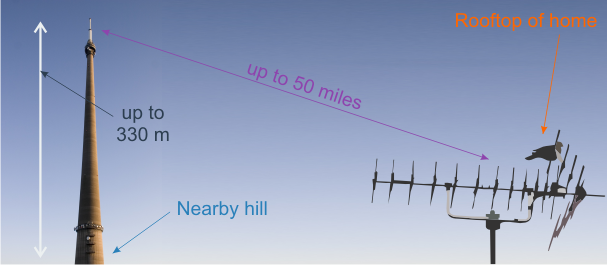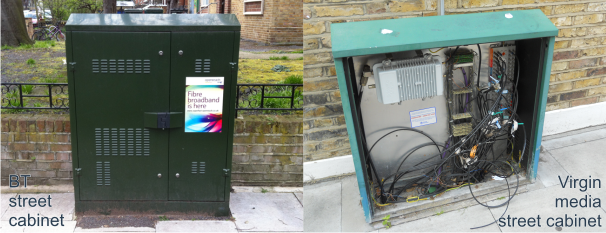Which free digital TV system will give me the most reliable reception?

How time flies! It was 12 years ago this week that Sky closed their analogue TV service, and it was five years ago that "digital switchover" started. It can be quite hard to remember the imperfections of analogue reception, as everyone now has crystal-clear digital TV.
All transmission systems (analogue or digital) have to deal with the real world. This means a range of weather and atmospheric conditions can cause reception problems. What can you do about it?
However, the binary "bits" that are translated into the moving pictures, stereo sound, on-screen TV listings, subtitles and interactive text services have to get themselves from the broadcaster to your TV set, still have to be transferred along the same airwaves as the old analogue services.
On feature of "digital television" is that is digital in both the sense of "being provided by computer technology" and "it works, or it doesn't".
There are four ways you can get digital TV into your home:

1. Using "Freeview", which is the name for the service that provides channels from tall transmitters based around the country. This system is often called "terrestrial" (relating to the earth) because the TV signals stay close to the ground. Almost every home in the UK has a rooftop aerial which picks up the signals and sends them down to the TV sets around the house.

2. Using satellites, which you will know by the names "Sky" or "Freesat". It is hard to fathom sometimes that the satellites are up in space, 22,236 miles above Africa in the Maiko National Park, Congo (not far from Rwanda). Satellite reception is no harder to set up than using an aerial, all you need is a small compact black disk mounted on a south-facing wall. 
3. Cable TV, which is known as "Virgin Media" in the UK, offers an alternative reception system. The cable company provides a wire into your home that provides a range of services. This is connected to a box in the street, which connects onto what is called a "head end" in your town or city: a room full of equipment where the TV channels are provided and encoded.
4. You may know Internet TV as "BT Vision" or "TalkTalk TV", or you might use BBC iPlayer, or Sky Now. To watch TV this way, your equipment connects to the internet using whatever method is to hand: ADSL (sharing a phone line), wireless, mobile or cable-provided.
Part two tomorrow: how they work - most of the time.
11:47 AM
KMJ,Derby: to be honey, most manufacturers only have HDMI on the back now, certainly Panasonic and Samsung does. That does make sense, since they have HD tuners, and therefore it's a reasonable expectation that they will be connected to at least HD-ready tv's. HDMI is now the standard, scart is legacy, and I've noticed that video RCA's have also now vanished.
Humax still has scart and hdmi, and I've recommended getting the t2 for a while to CRT owners, since they can use it for their present tv and any replacement.
As we keep seeing, people are still buying tv's and other equipment without thinking how its all going to fit together, and are still buying cheap tv's and are then surprised that the HD does not extend to the tuner - hopefully that will become less of a problem as t2 tuners become universal, but if you are buying a tv, a cheap one is often cheap for a reason.
| link to this comment |
1:18 PM
MikeB: The problem arises when the viewer has no intention of replacing their CRT tv, they merely want to add a DVB-T2 tuner to receive additional channels or continue to receive channels in the event of a DVT switch-off. I feel manufacturers should be required to provide connectability for older equipment as part of the process of encouraging viewers to aquire DVB-T2 tuners. Likewise anyone buying a tv could still want to connect games consoles, VCRs or DVD players that have scart outputs. Personally I find the harsh rasping sound on the present range of tv sets is enough reason to postpone indefinitely the purchase of any new flat panel model.
| link to this comment |
3:10 PM
KMJ,Derby: At some point CRT's are going to vanish, and if your a manufacturer, you have to think of the economics of producing connections which fewer and fewer people will be using.
Actually I agree with you, and not just because I have a CRT I cannot afford to replace at present! However, Humax and some other do continue to make equipment which does have scart (and I think RCA's as well).
In fact manufacturers actually do supply more connections on the back than most people actually use (Samsung used to have a DVI on the back of their 6000 series LED!) - However, HDMI is here to stay (although there will be one scart connection on the back of a modern TV, something which Samsung were doing five years ago), and we'll get used to it in time.
As for sound - thats what soundbars are for!
| link to this comment |
4:18 AM
Cardiff
FTTC uses fibre to the cabinet (as the name suggests), but then copper from the cabinet to your home. Thus it suffers from similar inadequacies as ADSL.
To call it "fibre Internet" is a misnomer.
I would call "fibre internet" FTTP.
| link to this comment |
Tim's: mapT's Freeview map terrainT's terrain plot wavesT's frequency data T's Freeview Detailed Coverage
7:35 AM
Tim that seems a bit confusing to me in my case I have copper from my home to the exchange. I can go FTTC, the cabinet is a long why away from me thus reduces the distance of copper by over half which still gives reductions.
FTTP what is that please?
I believe there is a term FTTH, fibre to the Home, but is it dream for BT to rip all copper?
I would suggest BT needs fibre cabinets in each street like Virgin have.
| link to this comment |
10:24 PM
David et al:
FTTC is fibre to the cabinet, FTTH is fibre to the home and FTTP is fibre to the premises.
FTTC is being rolled out by BT, and others, as a means if getting faster broadband services to home via a roadside cabinet. That can be fairly close or may be a mile or more away from the subscriber's home, the last link being done in copper pairs as is the 'traditional' landline.
FTTH is where the fibre is laid by the provider into the home, terminating is a mast connection that contains the electronics needed to recover the data signals from the light in the fibre and convert it into an electronic data stream. The 'box' is a modem designed for that purpose.
FTTP is a commercial project involving BT but other operators are also laying such services. The fibre is run right into the 'premises', which may be a factory, office block, a housing block (such as flats) or commercial premises.
In terms of benefits, FTTC usually shortens the copper length so increases the potential speed deliverable, but much still depends on copper line length and quality. FTTH means there is no copper used at all until the connection converts from fibre to internal telephone wiring and broadband modem/router, so it has considerable potential for fast broadband. FTTP can be expensive as high capacity fibre is brought into the building and signals distributed as required.
As for costs, FTTC is usually cheaper by contract but is quite costly to install because of the cabinets and equipment inside them. FTTP is usually charged at a higher rate as it is felt that those wanting the faster service are prepared to pay more for it. FTTH is again charged at a higher rate but less than FTTP as it's largely, but not exclusively, aimed at the SOHO market, etc.
Does that help clarify?
| link to this comment |
10:26 PM
Sorry, a few spelling errors crept in.
FTTH arrives at a master connection, not a mast.
| link to this comment |
10:26 PM
Bristol
I used the BBC's web form to report the problems that I've been having with iPlayer. Today I received a very nice and personal reply telling me that I was not the only person to have reported this problem and that the BBC are investigating possible causes and ways in which the problem can be remedied.
| link to this comment |
Charles's: mapC's Freeview map terrainC's terrain plot wavesC's frequency data C's Freeview Detailed Coverage
3:51 PM
In Alderney we have a Freeview Repeater that relays the FREMONT Point main transmitter. The Channel Islands don't have all the channels like the other main transmitters do. We have to resort to seeing some on Freesat. But some like Yesterday are not free. Our biggest problem is every so often the BBC transmitter, or the ITV one shuts off. Normally not both together, it can be for a few seconds or for several minutes or an hour or more. Considering we pay a licence fee its a very poor service from the local transmitter.
| link to this comment |
DougA: The Licence Fee pays for the BBC and, as a Public Service Broadcaster you have access to the BBC.
The channels that don't broadcast do so because they have no obligation to provide a Public Service, their main interest being to turn a profit.
Thus, if it weren't for Public Service Broadcasting you wouldn't have any TV.
| link to this comment |
